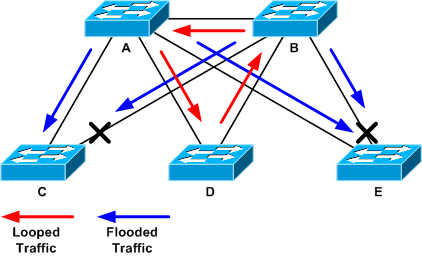A Switching loop or bridge loop occurs in computer networks when there is more than one Layer 2 (OSI model) path between two endpoints (e.g. multiple connections between two network switches or two ports on the same switch connected to each other). The loop creates broadcast storms as broadcasts and multicasts are forwarded by switches out every port, the switch or switches will repeatedly rebroadcast the broadcast messages flooding the network. Since the Layer 2 header does not support a time to live (TTL) value, if a frame is sent into a looped topology, it can loop forever.
A physical topology that contains switching or bridge loops is attractive for redundancy reasons, yet a switched network must not have loops. The solution is to allow physical loops, but create a loop-free logical topology using the shortest path bridging (SPB) protocol or the older spanning tree protocols (STP) on the network switches.
Broadcasts
In the case of broadcast packets (broadcast radiation) over a switching loop, the situation may develop into a broadcast storm.
MAC database instability
Switching loops can cause misleading entries in a switch's media access control (MAC) database and can cause endless unicast frames to be broadcast throughout the network. A loop can make a switch receive the same broadcast frames on two different ports, and alternatingly associate the sending MAC address with the one or the other port. It may then incorrectly direct traffic for that MAC address to the wrong port, effectively causing this traffic to be lost, and even causing other switches to incorrectly associate the sender's address with a wrong port as well.
Multiple frame transmissions
In a redundant switched network it is possible for an end device to receive the same frame multiple times.
Misinterpretations
It is not true that within a switching loop packets will circulate the network until their time to live (TTL) value expires, as no TTL concept exists at Layer 2. In practice, the packet will circulate until it is dropped, e.g. due to resource exhaustion.

